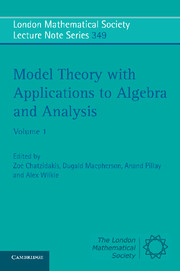Book contents
- Frontmatter
- Contents
- Preface
- Contributors
- Model theory and stability theory, with applications in differential algebra and algebraic geometry
- Differential algebra and generalizations of Grothendieck's conjecture on the arithmetic of linear differential equations
- Schanuel's conjecture for non-isoconstant elliptic curves over function fields
- An afterthought on the generalized Mordell-Lang conjecture
- On the definitions of difference Galois groups
- Differentially valued fields are not differentially closed
- Complex analytic geometry in a nonstandard setting
- Model theory and Kähler geometry
- Some local definability theory for holomorphic functions
- Some observations about the real and imaginary parts of complex Pfaffian functions
- Fusion of structures of finite Morley rank
- Establishing the o-minimality for expansions of the real field
- On the tomography theorem by P. Schapira
- A class of quantum Zariski geometries
- Model theory guidance in number theory?
Establishing the o-minimality for expansions of the real field
Published online by Cambridge University Press: 04 August 2010
- Frontmatter
- Contents
- Preface
- Contributors
- Model theory and stability theory, with applications in differential algebra and algebraic geometry
- Differential algebra and generalizations of Grothendieck's conjecture on the arithmetic of linear differential equations
- Schanuel's conjecture for non-isoconstant elliptic curves over function fields
- An afterthought on the generalized Mordell-Lang conjecture
- On the definitions of difference Galois groups
- Differentially valued fields are not differentially closed
- Complex analytic geometry in a nonstandard setting
- Model theory and Kähler geometry
- Some local definability theory for holomorphic functions
- Some observations about the real and imaginary parts of complex Pfaffian functions
- Fusion of structures of finite Morley rank
- Establishing the o-minimality for expansions of the real field
- On the tomography theorem by P. Schapira
- A class of quantum Zariski geometries
- Model theory guidance in number theory?
Summary
Introduction
A. Grothendieck introduced the notion of “tame geometry” in [8], more precisely in a chapter entitled “Denunciation of so-called general topology, and heuristic reflexions towards a so-called tame topology”. He says there that general topology has been “developed by analysts in order to meet the needs of analysis”, and “not for the study of topological properties of the various geometrical shapes”. Consequently, according to him, when one tries to work in the technical context of topological spaces, “one is confronted at each step with spurious difficulties related to wild phenomena”.
According to him, the correct answer should be, instead of “moving to contexts which are close to the topological one and less subject to wildness, such as differentiable manifolds or piecewise linear spaces”, to have an axiomatic approach towards possible foundations for a tame geometry. He suggests more precisely to extract, among the geometric properties of the semi-analytic sets in a space, those that make it possible to use these spaces as “local models” for a notion of “tame space”. For example, a triangulability axiom should be kept, although it is obviously “delicate to check”.
It is now widely admitted that the most convenient axiomatic answer to such a program is the notion of o-minimal structure. In particular, the tameness axiom for these structures, which limits the definable sets of the real line to finite union of points or intervals, seems more handy than a triangulability axiom.
- Type
- Chapter
- Information
- Model Theory with Applications to Algebra and Analysis , pp. 249 - 282Publisher: Cambridge University PressPrint publication year: 2008
- 1
- Cited by



